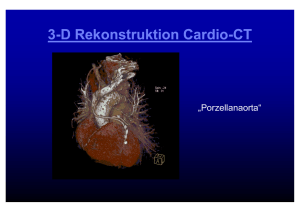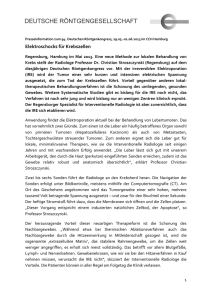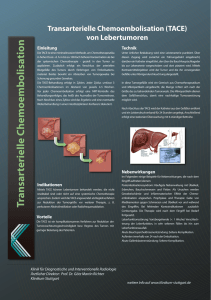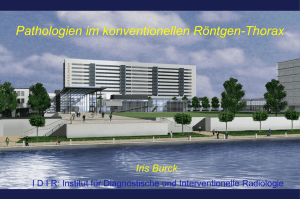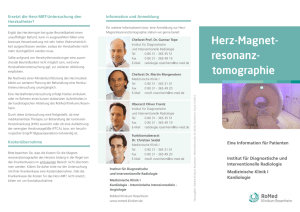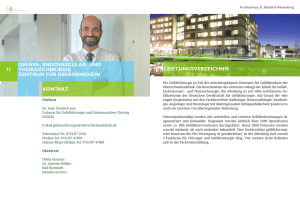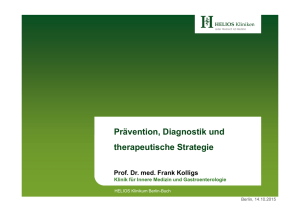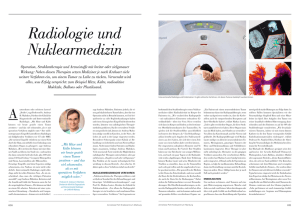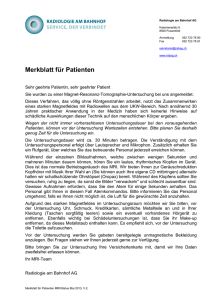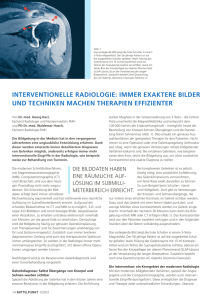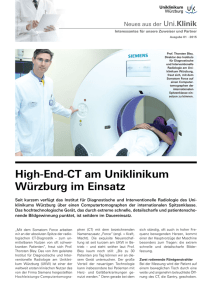HCC - Institut für Diagnostische und Interventionelle Radiologie
Werbung
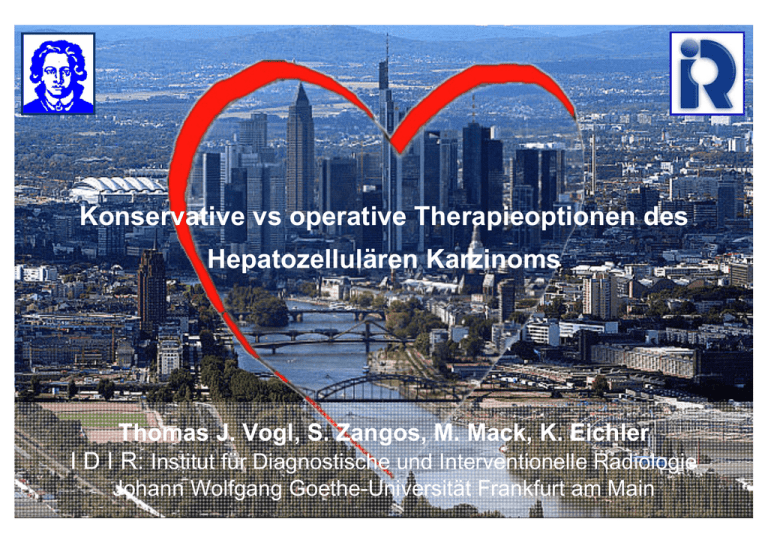
Konservative vs operative Therapieoptionen des Hepatozellulären Karzinoms Thomas J. Vogl, S. Zangos, M. Mack, K. Eichler I D I R: Institut für Diagnostische und Interventionelle Radiologie Johann Wolfgang Goethe-Universität Frankfurt am Main The Onculus U.S. Cancer Incidence U.S. Cancer Mortality Cancer Level I Evidence Institut für Diagnostische und Interventionelle Radiologie, J.W. Goethe-Universität, Frankfurt Hepatozelluläres Karzinom Klinisches Szenario I: 53-jähriger Patient Child A Zirrhose AFP = 30 µg/l V.a. solitäres HCC Prätherapeutisch: Resektion? Ablation? Post TACE: palliativ Institut für Diagnostische und Interventionelle Radiologie, J.W. Goethe-Universität, Frankfurt Hepatozelluläres Karzinom Klinisches Szenario II: 49-jährige Patientin Child B Zirrhose AFP = 1200 µg/l Palliative TACE Post TACE → potentiell kurative Ablation mittels LITT Institut für Diagnostische und Interventionelle Radiologie, J.W. Goethe-Universität, Frankfurt Minimalinvasive Therapie des HCC • Onkologische Konzepte • Intervention: - Technik - Patientenmanagement • Indikationen: - neoadjuvant - bridging - palliativ - symptomatisch • Neue Entwicklungen/Schlussfolgerung Institut für Diagnostische und Interventionelle Radiologie, J.W. Goethe-Universität, Frankfurt HCC: Palliatives Therapiekonzept 1. Symptomatische Therapie: • Kapselschmerz • Rezidivierende Tumorblutung • Therapie bei Metastasen 2. Palliatives/potentiell kuratives Therapiekonzept: • Lokale Tumorkontrolle • Kontrolle von Satelliten • Optimale Ergebnisse durch kombinierte Therapieverfahren Institut für Diagnostische und Interventionelle Radiologie, J.W. Goethe-Universität, Frankfurt HCC: Therapieoptionen Therapieoption Chirurgisch: Resektion Lebertransplantation Lokal-ablativ: Perkutane Äthanolinjektion (PEI) Radiofrequenzablation (RFA) Kryotherapie/laserinduzierte interstitielle Thermotherapie Chemoembolisation (TACE) Bewertung Einziger kurativer Ansatz - Kurativ für singuläre Herde < 3 cm bei guter Leberfunktion - Kurativ bei singulären Herden bis 5 cm oder bis zu 3 Herden < 3 cm Bei Kontraindikation für chirurgische Therapie - Singuläre Herde bis 5 cm, bis zu drei Herde < 3 cm, wenn Lebertransplantation nicht möglich, auch wenn Leberfunktion eingeschränkt ist - Multiple Herde bis 5 cm, in Zukunft auch größer, auch bei eingeschränkter Leberfunktion - Momentan keine wesentlichen Vorteile gegenüber RFA - Reservemethode bei multiplen, großen Herden und eingeschänkter Leberfunktion (Überlebensvorteil nur bei guter Funktion) Institut für Diagnostische und Interventionelle Radiologie, J.W. Goethe-Universität, Frankfurt Algorithm for the Management of Patients with Hepatocellular Carcinoma Hepatocellular Carcinoma Imaging (US, CT, MRI, FDG-PET) Liver function tests Transplantation criteria Waiting list for transplantation Child‘s Pugh A, B, C No vascular invasion or extrahepatic disease consider YES Central tumor location tumor control 1 tumor < 5 cm or with local less than 3 tumors < 3 cm ablative therapy NO Resection Ablation: RF, LITT Resection criteria Child‘s Pugh A or B YES No vascular invasion or extrahepatic disease NO Peripheral tumor location Free resection margin possible Unresectable Jansen MC MC et et al, al, Eur Eur JJ Surg Surg Oncol Oncol 2005; 2005; 31(4):331-47 31(4):331-47 Jansen Institut für Diagnostische und Interventionelle Radiologie, J.W. Goethe-Universität, Frankfurt Algorithm for the Management of Patients with Hepatocellular Carcinoma Unresectable Patients unfit for liver surgery Tumor > 5 cm Diffuse neoplasm Patients unfit for liver surgery Tumor < 5 cm Less than 3 tumors No vascular invasion Child‘s Pugh A or B No portal vein thrombosis Child‘s Pugh C Child‘s Pugh A or B Tumor < 3 cm Child‘s Pugh A or B Tumor 3-5 cm TACE Palliative care RFA ILC Cryoablation PEI Multi session RFA Multiple fiber ILC Multiple probe Cryo ‚Single session‘ PEI Reconsider resection or transplantation Jansen MC MC et et al, al, Eur Eur JJ Surg Surg Oncol Oncol 2005; 2005; 31(4):331-47 31(4):331-47 Jansen Institut für Diagnostische und Interventionelle Radiologie, J.W. Goethe-Universität, Frankfurt Vorstellung einer 3D-Planung zur Planung der therapeutischen Strategie bei multifokalem HCC Tumorvolumina Vaskuläre Leitstrukturen Institut für Diagnostische und Interventionelle Radiologie, J.W. Goethe-Universität, Frankfurt Regionale Chemotherapie der Leber: Konzepte 1. Transarterielle Embolisation (TAE) 2. Transarterielle Chemoembolisation (TACE) 3. Regionale arterielle Chemoperfusion (RCP) - Perkutaner Katheter - Perkutaner i.a. Port (RP) (4. Portale Chemoperfusion) 5. Yttrium-90 Radiochemoembolisation Institut für Diagnostische und Interventionelle Radiologie, J.W. Goethe-Universität, Frankfurt Ziele der TACE • Optimierung und Erhöhung der Wirksamkeit der lokalen Chemotherapie • Geringe systemische Nebenwirkungsrate • Gute Lebensqualität • Verlängerung des Überlebens • Überführung einer primären Inoperabilität in eine operable Situation Institut für Diagnostische und Interventionelle Radiologie, J.W. Goethe-Universität, Frankfurt Prinzip der Chemoembolisation • Embolisation der Leberarterien: Ischämische Tumornekrosen Schonung des normalen Lebergewebes • Kombination der arteriellen Okklusion und der lokalen Zytostatikatherapie: Partielle Wirkungsverstärkung der Chemotherapeutika bei Hypoxie Erhöhte Zytostatikaextraktion bei langsamer Leberpassage Institut für Diagnostische und Interventionelle Radiologie, J.W. Goethe-Universität, Frankfurt Zöliakographie Z öliakographie • Sondierung des Truncus coeliacus mittels Sidewinderoder Cobrakatheter (ventraler Abgang in Höhe Th12- LWK1) • Übersichtsuntersuchung vor selektiver Gefäßsondierung • Aufteilung in 3 große Äste: - A. hepatica communis - A. lienalis - A. gastrica sinistra • KM-Menge: 20 - 30 ml • Flow: 5 - 8 ml/s • Bildfrequenz: 1/s Institut für Diagnostische und Interventionelle Radiologie, J.W. Goethe-Universität, Frankfurt Chemoocclusion: Steigerung der therapeutischen Effizienz • Reduktion des arteriellen Flows führt umgekehrt proportional zur Erhöhung des Effizienzfaktors E • Permanentocclusion: Polyvinylschaum, Ivalon 150-590 µm Partikelgröße • Kurzzeitocclusion: Stärkemikrosphären, DSM Spherex, 45 ± 7 µm, T1/2 = 25 min Gelatine, Gelfoam, 10-50 µm, T1/2 = 100 min Fettsäureäthylester, Lipiodol 10-150 µm Institut für Diagnostische und Interventionelle Radiologie, J.W. Goethe-Universität, Frankfurt Instillation des Embolisates • Flussgesteuerte Instillation der Zytostatikum-Lipiodol-Emulsion ⇒ Schonung des Abganges: • A. cystica • A. gastroduodenalis ⇒ Ausschluß einer a.v.Verbindung • Okklusion der kleinen Arterien mit Spherex (maximal: 450 mg) Institut für Diagnostische und Interventionelle Radiologie, J.W. Goethe-Universität, Frankfurt TACE: Kontraindikationen • Operabilität der Tumoren • Tumorbefall der Leber > 75% • Karnofsky-Index < 50 • Floride Infektionen • Myelodepression: - Leukozyten < 2.000/µl - Thrombozyten < 40.000/µl Institut für Diagnostische und Interventionelle Radiologie, J.W. Goethe-Universität, Frankfurt Patientenmanagement post TACE • Überwachungszeitraum: 6 Stunden • Kontroll-MRT nach 6 Stunden: - Größenentwicklung der Metastasen • Kontroll-CT nach 24 Stunden: - Lipiodolbelegung/Embolisatverschleppung • 3 Zyklen: - Wiederholung alle 4 Wochen Institut für Diagnostische und Interventionelle Radiologie, J.W. Goethe-Universität, Frankfurt TACE: Patienten (n=2.551) 10.951 TACE-Behandlungen (MW: 4,3 TACE/Patient) ♀/♂ = 274/528 15% 6% 15% 3.775 TACE (MW 4,7 TACE/Patient) 4% 3% 2% 18% 2% 2% 32% Kolorektales Ca (n=802) Mamma-Ca (n=460) HCC (n=385) Andere (n=393) Pancreas-Ca (n=150) Cholangio-Ca (n=107) Bronchial-Ca (n=82) Nieren-Ca (n=59) Ovarial-Ca (n=45) Karzinoid (n=42) CUP (n=36) 01/01/1999 –15/08/2006 Institut für Diagnostische und Interventionelle Radiologie, J.W. Goethe-Universität, Frankfurt HCC – TACE: Indikationsstellung 5% 64% Neoadjuvant Neoadjuvant (n=48) (n=120) 31% ♀/♂ = 100/285 1.613 TACE-Behandlungen Palliativ Palliativ(n=99) (n=246) Symptomatisch Symptomatisch (n=8) (n=19) (MW 4,2 TACE/Patient) Institut für Diagnostische und Interventionelle Radiologie, J.W. Goethe-Universität, Frankfurt HCC: Indikationen zur TACE I. Palliativ II. Kurativ III. Neoadjuvant a) vor Ablation (RFA/LITT) b) vor PEI c) vor Resektion d) vor Transplantation Primäre lokale Tumorkontrollrate 5-JahresÜberlebensrate 15-60% 18-63% 8-43% 18-63% 82% 54% 70% 55-86% 27-72% 54-93% IV. Symptomatisch Institut für Diagnostische und Interventionelle Radiologie, J.W. Goethe-Universität, Frankfurt HCC: Palliative TACE Prä-TACE 1. TACE 3. 4. Institut für Diagnostische und Interventionelle Radiologie, J.W. Goethe-Universität, Frankfurt Überleben: TACE-Indikation MW: 35,7 Monate MW: 24,5 Monate MW: 8,2 Monate Institut für Diagnostische und Interventionelle Radiologie, J.W. Goethe-Universität, Frankfurt Überleben: Ü berleben: Vergleich der Therapie MW: 36.9 Monate MW: 33.3 Monate TACE-LITT (n=32) LITT (n=28) MW: 25.0 Monate TACE (n=123) Institut für Diagnostische und Interventionelle Radiologie, J.W. Goethe-Universität, Frankfurt TACE bei HCC: I. Palliative Indikationsstellung • Kriterien: Keine Resektabilität Keine Ablation Keine Transplantation • Ergebnisse: Überlebensraten → Palliative Therapie > symptomatische Therapie → Lokales Therapieansprechen: 28-53% 85% → 1-J-ÜR → 2-J-ÜR 38,6% → 3-J-ÜR 18,1% Institut für Diagnostische und Interventionelle Radiologie, J.W. Goethe-Universität, Frankfurt TACE bei HCC: II. Kurative Indikationsstellung Abbruch der Studie wegen Überlebensvorteil bei TACE Embo Kontrolle TACE 1-Jahres-Überleben: 75% 63% 82% 2-Jahres-Überleben: 50% 27% 63% Llovet et al, Lancet 2002; 359:1734-39 Institut für Diagnostische und Interventionelle Radiologie, J.W. Goethe-Universität, Frankfurt TACE bei HCC: III. Neoadjuvante Indikationsstellung • IIIa. Vor Ablation - RFA: Ischämie Hypoxie Nekrose Nachteil: ↑ ↑ ↑ erschwerte Bildgebung durch Lipiodolspeicherung Complete response: HCC ≤ 50 mm – 84-90% HCC > 50 mm – ≤ 64% Intrahepatische Rezidivrate: 1 Jahr: 15% 2 Jahre: 43% Institut für Diagnostische und Interventionelle Radiologie, J.W. Goethe-Universität, Frankfurt TACE bei HCC: III. Neoadjuvante Indikationsstellung • IIIa. Vor Ablation - LITT: Complete Response: Survival rate: 66,7% 36 Monate • IIIb. Vor PEI: Komplette Tumornekrose ↑ Vitale Restzellen ↓ 1 J-Überleben: 79 – 100% TACE + PEI: 92% (Bartolozzi) 2 J-Überleben: 39% (Lubienski) Institut für Diagnostische und Interventionelle Radiologie, J.W. Goethe-Universität, Frankfurt Large-sized HCC: A Neoadjuvant Treatment Protocol with Repetitive Transarterial Chemoembolization before MR-guided LITT • Results: repeated TACE: → reduction in tumor size: n = 32 pat. (66.7%) → stable disease: n = 12 pat. → progression: n = 4 pat. n = 32 pat. MR-guided LITT: (1 to 4 treatments, mean: 1.9 per patient) → median survival after 1st treatment: 36.0 months • Conclusion: neoadjuvant TACE appears to be an effective treatment of large-sized HCC, which extends the indication for MR-guided LITT. Zangos S, Vogl T J, Eur Radiol 2006, Aug 8 Institut für Diagnostische und Interventionelle Radiologie, J.W. Goethe-Universität, Frankfurt TACE bei HCC: III. Neoadjuvante Indikationsstellung • IIId. TACE vor LTX: • Einschlusskriterien: (Milano) 1 HCC-Herd ≤ 5 cm 3 HCC-Herde ≤ 3 cm • Ausschlusskriterien: → Extrahepatische Metastasierung → Infektion → Manifeste Koagulopathie Rezidivfreies Überleben nach TACE+LTX: → 54-71% Komplette Remission nach TACE im Explantat: → 16-23% Institut für Diagnostische und Interventionelle Radiologie, J.W. Goethe-Universität, Frankfurt TACE bei HCC: IV. Symptomatische Indikationsstellung Institut für Diagnostische und Interventionelle Radiologie, J.W. Goethe-Universität, Frankfurt Prospective Randomised Study of Doxorubicin in the Treatment of Hepatocellular Carcinoma by Drug-eluting Bead Embolisation: Precision V • 16 europäische Zentren in Deutschland, Österreich, Frankreich und der Schweiz • 200 Patienten (100/Arm) • 10-15 Patienten pro Zentrum • 3 Behandlungen in 6 Monaten • Ziel: → Sicherheit und Wirksamkeit von DC Beads verglichen mit konventioneller TACE Institut für Diagnostische und Interventionelle Radiologie, J.W. Goethe-Universität, Frankfurt HCC: Precision V 52-jähriger Patient mit solitärem Hepatitis C-assoziiertem HCC 2 Knoten im rechten Leberlappen: Segment 7: 6 x 6 cm Segment 8: 2 x 2 cm 3-malige Therapie mit je 150 mg Doxorubicin geladen in 4 ml DC Beads 1 MoVor 3 nach Therapie DC beads Institut für Diagnostische und Interventionelle Radiologie, J.W. Goethe-Universität, Frankfurt Tumorablation: Philosophie I. Gezielte Tumorbehandlung II. Umschriebene Nekrosebildung III. Steuerbare Nekroseausdehnung IV. Wiederholbar Institut für Diagnostische und Interventionelle Radiologie, J.W. Goethe-Universität, Frankfurt Ablation : Tierexperimentelle Daten Ergebnis: Ablation vs. Resektion Tumorablation (LITT) verzögert und vermindert • Residuelles intrahepatisches Tumorwachstum • Makroskopische peritoneale Tumorzellaussaat Isbert, Gemer et al, British Journal of Surgery 2002; 89:1252-1259 Institut für Diagnostische und Interventionelle Radiologie, J.W. Goethe-Universität, Frankfurt Hepatocellular Carcinoma Long-term Survival Outcomes of Patients with Early-Stage HCC Receiving Potentially Curative Treatment: Results from Western Series Treatment # of patients 1-y-survival 5-y-survival Liver transplantation Bismuth et al, 1999 Llovet et al, 1999 Jonas et al, 2001 Surgical resection Llovet et al, 1999 Fong et al, 1999 Wayne et al, 2002 Ethanol injection Lencioni et al, 1995 Livraghi et al, 1995 Child class A, single HCC Child class B, single HCC Radiofrequency ablation Current study Child class A, single HCC 45 79 120 82% 86% 90% 74% 75% 71% 77 100 249 85% 83% 83% 51% 42% 41% 105 96% 32% 293 149 98% 93% 47% 29% 187 116 97% 100% 48% 61% Lencioni R et al, Radiology 2005; 234:961-967 Institut für Diagnostische und Interventionelle Radiologie, J.W. Goethe-Universität, Frankfurt Hepatozelluläres Hepatozellul äres Karzinom Perkutane Ethanol-Injektion Diffusion in den Tumor Zellhydratation Proteindenaturierung Chemische Vaskulitis Thrombose + Okklusion der Gefäße Koagulationsnekrose Institut für Diagnostische und Interventionelle Radiologie, J.W. Goethe-Universität, Frankfurt Radiofrequenzablation: Elektrodentechniken • Gekühlte/ungekühlte Monoelektrode • Gekühlte Clusterelektrode • Ausfahrbare Elektroden • Bipolare Applikatoren Institut für Diagnostische und Interventionelle Radiologie, J.W. Goethe-Universität, Frankfurt RF-Therapie RF -Therapie Nach 24 h Nach 6 Monaten Institut für Diagnostische und Interventionelle Radiologie, J.W. Goethe-Universität, Frankfurt Hepatocellular Carcinoma: RF-Ablation vs PEI • Patients: RF: n = 52 PEI: n = 50 • Mean Follow-up: RF = 22.9 months PEI = 22.4 months RF PEI • Survival rates: 1-J-Ü 2-J-Ü 100% 98% 96% 88% • Local recurrence-free survival rates 1-J-Ü 2-J-Ü 98% 83% 96% 62% Lencioni R et al, Radiology 2003; 228:235-240 Institut für Diagnostische und Interventionelle Radiologie, J.W. Goethe-Universität, Frankfurt RFA of Hepatocellular Carcinoma: Treatment Success as Defined by Histologic Examination of the Explanted Liver • Results: successfully treated tumors: tumors < 3 cm: n = 35/47 (74%) n = 29/35 (83%) successfully treated nodules – max diameter: 20 mm unsuccessfully treated nodules – max diameter: 31 mm successfully treated perivascular lesions: n = 7/15 (47%) successfully treated nonperivascular lesions: n = 28/32 (88%) postablation CT/MR imaging – depiction of residual or recurrent tumor: specificity: 100% sensitivity: 36% Lu D et al, Radiology 2005; 234:954-960 Institut für Diagnostische und Interventionelle Radiologie, J.W. Goethe-Universität, Frankfurt Power-Laser Applikationssystem MR-gesteuerte MR -gesteuerte LITT Institut für Diagnostische und Interventionelle Radiologie, J.W. Goethe-Universität, Frankfurt MR-gesteuerte MR -gesteuerte LITT 0 min 1 min 3 min 12 min Institut für Diagnostische und Interventionelle Radiologie, J.W. Goethe-Universität, Frankfurt LITT: 10 Jahre Follow Follow-up -up Institut für Diagnostische und Interventionelle Radiologie, J.W. Goethe-Universität, Frankfurt LITT Lebermetastasen: 06/1993 - 04/2006 • Patienten: Mittleres Alter • Läsionen: n = 1.656 59,9 Jahre (23 - 89 J) Gesamtzahl Punktionen LITT-Applikationen Behandlungssitzungen n = 4.429 n = 10.321 n = 18.716 n = 3.775 Gruppe 1: Gruppe 2: KurativeAbsicht (n=1.206) ≤ 5 Lebermetastasen < 5 cm ∅ Keine extrahepat. Erkrankung Palliative Absicht (n=450) > 5 Lebermetastasen > 5 cm ∅ Extrahepatische Erkrankung (z.B. Lunge, LK, Skelett) Institut für Diagnostische und Interventionelle Radiologie, J.W. Goethe-Universität, Frankfurt HCC: Laser-induzierte Thermotherapie (LITT) • Patienten: Mittleres Alter: n = 90 66.6 Jahre (32-83 Jahre) • Läsionen: Gesamtzahl Punktionen LITT-Applikationen Behandlungssitzungen n = 140 n = 317 n = 600 n = 140 (10/1993 - 04/2006) Institut für Diagnostische und Interventionelle Radiologie, J.W. Goethe-Universität, Frankfurt Überlebenskurve HCC: HCC: 90 90 Pat., Pat., 140 140 HCC-Knoten HCC-Knoten Überlebenskurve Mittelwert: 4.3 Jahre (95% CI: 3.6 – 5.0) 1,0 1-Jahres-Überlebensrate: 96% 2-Jahres-Überlebensrate: 74% ,8 Cum Survival 3-Jahres-Überlebensrate: 57% 5-Jahres-Überlebensrate: 37% ,6 Berechnung: ab Diagnosedatum des gelaserten HCC-Knotens ,4 ,2 0,0 0 2 4 6 survival time [years] 8 10 (10/1993 - 04/2006) Überlebenskurve HCC: HCC: 90 90 Pat., Pat., 140 140 HCC-Knoten HCC-Knoten Überlebenskurve Mittelwert: 3.5 Jahre (95% CI: 2.8 – 4.3) 1,0 1-Jahres-Überlebensrate: 82% 2-Jahres-Überlebensrate: 58% ,8 Cum Survival 3-Jahres-Überlebensrate: 43% 5-Jahres-Überlebensrate: 27% ,6 Berechnung: ab 1. LITT ,4 ,2 0,0 0 2 4 6 survival time [years] 8 10 (10/1993 - 04/2006) Therapeutische Strategie HCC n <5 ∅ < 5 cm • Leber- oder Tumorresektion • Transplantation • LITT, RF n <5 ∅ < 8 cm n >5 ∅ > 8 cm • „Neoadjuvante“ Chemoembolisation • Response ⇒ LITT, RF, Resektion • Palliative Chemoembolisation • Symptomatische Chemoembolisation Institut für Diagnostische und Interventionelle Radiologie, J.W. Goethe-Universität, Frankfurt Solitär - ohne Zirrhose Solitär - mit Zirrhose Solitär - ohne Zirrhose Solitär - mit Zirrhose f/uCT CT 6MRT Mo vor vorpost LITT LITT LITT ven art MRT f/u CT MRT 3 post Mo vor post 3. TACE LITT Multifokal - pot. kurativ Diffus - Palliativ Multifokal - pot. kurativ Diffus - Palliativ MRT MRT MRT 24h postvor post 3. TACE LITT CT MRT 24h post vor TACE Institut für Diagnostische und Interventionelle Radiologie, J.W. Goethe-Universität, Frankfurt Algorithm for the Management of Patients with Hepatocellular Carcinoma Unresectable Patients unfit for liver surgery Tumor > 5 cm Diffuse neoplasm Patients unfit for liver surgery Tumor < 5 cm Less than 3 tumors No vascular invasion Child‘s Pugh A or B No portal vein thrombosis Child‘s Pugh C Child‘s Pugh A or B Tumor < 3 cm Child‘s Pugh A or B Tumor 3-5 cm TACE Palliative care RFA ILC Cryoablation PEI Multi session RFA Multiple fiber ILC Multiple probe Cryo ‚Single session‘ PEI Reconsider resection or transplantation Jansen MC MC et et al, al, Eur Eur JJ Surg Surg Oncol Oncol 2005; 2005; 31(4):331-47 31(4):331-47 Jansen Institut für Diagnostische und Interventionelle Radiologie, J.W. Goethe-Universität, Frankfurt Interdisziplinäres Interdisziplin äres Arbeiten „If you you have have aa hammer, hammer, Radiologie „If Chirurgie everything everything looks looks like like aa nail.“ nail.“ Onkologie Gastroenterologie Institut für Diagnostische und Interventionelle Radiologie, J.W. Goethe-Universität, Frankfurt Coffee Break & HCC • In the Japanese population, habitual coffee drinking may be associated with reduced risk of HCC. Inoue M et al, J Natl Cancer Inst 2005; 97:293-300 • Although not statistically significant, an increase in HCC risk was observed among light smokers carrying GSTT1 null and NAT2 slow acetylator genotypes. Gelatti U et al, Int J Cancer 2005; 115(2):301-6 • Tobacco smoking and heavy alcohol consumption are associated with increased risk of HCC, especially when these 2 exposures occur together. Kuper H et al, Int J Cancer 2000; 85(4):498-502 Institute of Diagnostic and Interventional Radiology, J.W. Goethe University, Frankfurt Thanks to ... Institut für Diagnostische und Interventionelle Radiologie, J.W. Goethe-Universität, Frankfurt HCC: Response to TACE • Purpose: to evaluate the apparent diffusion coefficient (ADC) & choline level (1H-MRS) in monitoring the therapeutic response of HCC to TACE • Patients: n = 20 – HCC nodules > 3 cm • Results: - preinterventional choline levels: → HCC – x- = 4.0 mmol/L (0.0-17.2) → healthy volunteers – x- = 1.6 mmol/L (0.0-2.1) - post TACE: ↓ decrease of choline (p<0.01) ↑ increase of ADC • Conclusion: choline levels & ADC may allow therapy monitoring Chen C Y et al, Radiology 2006; 239:448-456 Institute of Diagnostic and Interventional Radiology, J.W. Goethe University, Frankfurt Quadruple-Phase MDCT of the Liver in Patients with Suspected HCC: Effect of CM Flow Rate • Purpose: To evaluate the effect of contrast material flow rate (3 ml/sec vs 5 ml/sec) on the detection and visualization of HCC and the safety profile of iodixanol at different injection rates • Materials and methods: - Patients: n = 97 - HCC: n = 245 - Iodixanol: 320 mg/L (1.5 mL/kg body weight) - Evaluation: qualitative and quantitative analyses safety assessment Schima W, Hammerstingl R, Vogl T J et al, AJR 2006; 186:1571-79 Institute of Diagnostic and Interventional Radiology, J.W. Goethe University, Frankfurt Quadruple-Phase MDCT of the Liver in Patients with Suspected HCC: Effect of CM Flow Rate • Results: - 5 ml/sec → detection of more lesions ≤ 1 cm - late arterial phase → more lesions than early phase - higher flow did not increase patient discomfort or CM-related adverse events • Conclusion: - detection of HCC → flow rate of 5 ml/sec recommended - late phase imaging is advantageous Schima W, Hammerstingl R, Vogl T J et al, AJR 2006; 186:1571-79 Institute of Diagnostic and Interventional Radiology, J.W. Goethe University, Frankfurt
